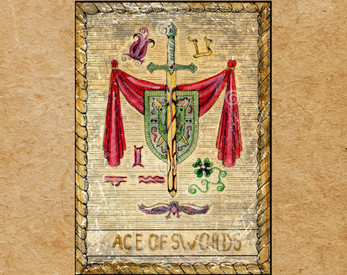Ace of Swords
Welcome to Ace of Swords, the fencing card game!
Concept
A key tenet in swordsmanship (and any martial art, really) is that your attack should become your next guard. This means that when you attack, you don’t leave yourself wide open: your very attack protects you.
With this in mind, I’ve created a simple card game in which your Attacks succeed only when they penetrate your opponent’s Guard, and at the same time, become your Guard, which your opponent must in turn strike through.
It is also true in real life that the guard you assume tends to limit your options for attacking (or risk them being too predictable). Here, this has solidified into a rule: you must guess what your opponent will do by observing their Guard. Failing to anticipate your opponent is, like in real life, a costly possibility.
In this version of Ace of Swords, you’ll play the most balanced and therefore fundamental class: the Swordsman, who wields a two-handed longsword. For simplicity’s sake, the Cards you can play and those you play against are reduced to the most basic movements. We will also not concern ourselves with card types, decks, and cards per hand / round / duel. As for you opponent, you’ll face a rather rudimentary enemy AI.
But think of this game as a tutorial for future versions to come, with an ever-widening range of possible features!
- More classes, like the rapier-and-dagger wielding Duelist, whose defense, though not great, is completely independent of their attacks; the shortsword-and-greatshield wielding Legionnaire, who can block in all directions but at the expense of attacking; or the Halberdier, whose attacks leave them wide open, but has the advantage of reach.
- Not only would reach be another factor to take into account, but also attacks from the sides and from behind, deflections that change your opponent’s guard, charging in to perform special techniques that immobilize or disarm.
- Double up complexity by taking into account left and right sided Attacks and Guards.
- Rounds could consist of a series of moves played with different amount of Cards, like the single-carded Opening Move, the threefold Combo Move, and the last Finishing Move.
- Cards could be played offensively so they’d act sooner, or defensively so they’d act in response to the other.
- Online PvP duels!
Rules
The goal of the game is to defeat your opponent in a Card Duel through a series of Rounds. Each Fighter has a set number of Lives. Win a Round to deplete one of your opponent’s Lives. The first to run out of Lives loses!
Rounds are won by the Fighter who deals the most Hits throughout it. If no Hits are dealt, no Lives are depleted. If both deal an equal number of Hits, both lose a Life.
(For this game’s purpose, both Fighters are considered aptly armored, so a Hit to the head will not be lethal, but just as damaging as any other).
When a Round begins, each Fighter must assume a Guard. Then, they must simultaneously play one Card, which opposes and affects the other. Your aim should be for your Card to protect you while dealing a Hit to your opponent. Sometimes, both Fighters will exchange Hits while some other times no Hits will be dealt (this can be to your advantage if you’ve accumulated enough Hits).
This process is repeated until the board is filled, thus ending the Round. Take heed that since Cards are played simultaneously, they both take effect at the same time. In order to have the upper hand, you must read your opponent’s Guard to anticipate them and strike true!
Unless deprived of it, Fighters always have one of three Guards, and can switch between them as they play Cards. Hits connect when an Attack does not encounter a Guard. Your Guard also defines which Attacks can be performed (Cards that can’t be played in your current Guard will not show up in you Hand). Some Cards do not change your Guard at all, others vary depending on your current Guard, and others yet may leave you Guardless!
- The High Guard allows and defends against High Attacks (those from above or to the head).
- The Mid Guard allows and defends against Mid Attacks (aimed at the midsection of the body).
- The Low Guard allows and defends against Low Attacks (from below or to the legs).
Source Code
Check out the project’s GitHub at: https://github.com/Sanctyakov/AceOfSwords
All assets are Royalty Free.
| Status | Released |
| Platforms | HTML5 |
| Author | Santiago Casini |
| Genre | Card Game |
| Made with | Unity |
